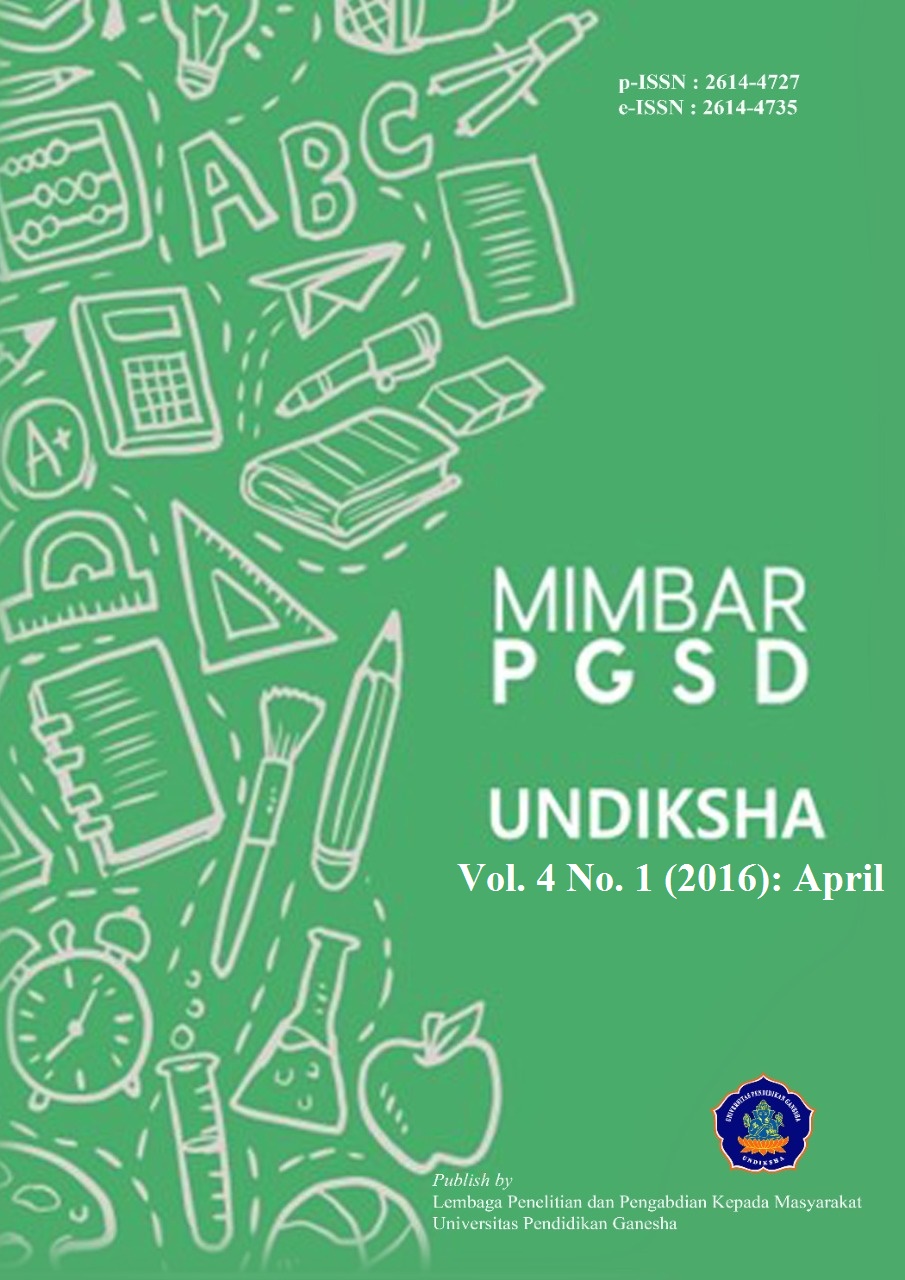PENGARUH MODEL PEMBELAJARAN TWO STAY TWO STRAY BERBANTUAN PETA KONSEP TERHADAP HASIL BELAJAR IPS SISWA KELAS V SD GUGUS I KECAMATAN GIANYAR TAHUN 2015/2016
DOI:
https://doi.org/10.23887/jjpgsd.v4i1.7052Abstract
Penelitian ini bertujuan untuk mengetahui perbedaan hasil belajar IPS antara kelompok siswa yang mengikuti pembelajaran menggunakan model pembelajaran Two Stay Two Stray berbantuan Peta Konsep dengan kelompok siswa yang mengikuti pembelajaran menggunakan model pembelajaran konvesional pada siswa kelas V SD Gugus I Kecamatan Gianyar Tahun 2015/2016. Jenis penelitian ini adalah penelitian eksperimen semu dengan menggunkan rancangan Nonequivalent control group design. Populasi penelitian ini adalah siswa kelas V di Gugus I kecamatan Gianyar. Sampel penelitian ini adalah siswa kelas V SD N 5 Gianyar sebagai kelas eksperimen dan siswa kelas V SD N 4 Gianyar sebagai kelas kontrol dengan jumlah masing-masing kelompok sebanyak 32 orang. Data penelitian ini dikumpulkan dengan metode tes, dengan tes pilihan ganda, yang berjumlah 40 soal yang telah di validitas. Hasil penelitian yang diperoleh adalah nilai rata-rata kelompok eksperimen sebesar 82,31 dan nilai rata-rata kelompok kontrol sebesar 71, 75. Hasil pengujian pot-test diperoleh data dari kelompok eksperimen dan kelompok kontrol berdistribusi normal dan homogen. Analisis data yang digunakan menguji hipotesis adalah uji t. Kriteria pengujian jika t_(hitung )>t_(tabel )maka Ho ditolak dan Ha diterima dengan dk=n_1+ n_(2 )- 2 dan signifikansi = 5%. Hasil uji hipotesis diperoleh t_(hitung )=4,722 dan t_(tabel )=2,000 maka t_(hitung )>t_(tabel )yaitu 4,722 > 2, 000 sehingga Ho ditolak dan Ha diterima. Berdasrkan hasil penelitian tersebut dapat disimpulkan bahwa terdapat pengaruh penerapan model pembelajaran Two Stay Two Stray berbantuan Peta Konsep terhadap hasil belajar IPS siswa kelas V SD Gugus I kecamatan Gianyar tahun ajaran 2015/2016.Kata Kunci : model two stay two stray, peta konsep, hasil belajar IPS
This study aims to determine the differences between the results of social studies students who take learning using learning model Two Stay Two Stray aided Map Concept with a group of students who take learning with conventional learning models in class V SD Gugus I Kecamatan Gianyar Year 2015/2016. This research is a quasi-experimental research design by using Nonequivalent control group design. The study population was fifth grade students in Gugus I Kecamatan Gianyar. Samples were students of class V SD N 5 Gianyar as experimental class and fifth grade students of SD N 4 Gianyar as the control class with the number of each group of 32 people. The research data was collected with the test method, with multiple-choice tests, which consist of 40 questions that have been on the validity. The results obtained are the average value of the experimental group at 82.31 and the average value of the control group at 71, 75. The test results obtained pot-test data from the experimental group and the control group with normal distribution and homogeneous. Analysis of the data used to test the hypothesis is t test. Criteria testing if Tcount > Ttable, then Ho is rejected and Ha accepted by dk = n1+n2 - 2 and its significance = 5%. Hypothesis test results obtained Tcount = 4,722 and Ttable = 2,000 then Tcount > Ttable that is 4,722 > 2, 000 so that Ho rejected and Ha accepted. Pursuant to these results we can conclude that there are significant application of learning models Two Stay Two Stray aided Concept Maps on learning outcomes students of class V SD IPS Cluster I Kecamatan Gianyar academic year 2015/2016.
keyword : model two stay two stray, concept maps, social learning outcomes
Published
2016-06-21
How to Cite
., N. P. I. P., ., D. I. K. A., & ., D. I. K. A. P. (2016). PENGARUH MODEL PEMBELAJARAN TWO STAY TWO STRAY BERBANTUAN PETA KONSEP TERHADAP HASIL BELAJAR IPS SISWA KELAS V SD GUGUS I KECAMATAN GIANYAR TAHUN 2015/2016 . MIMBAR PGSD Undiksha, 4(1). https://doi.org/10.23887/jjpgsd.v4i1.7052
Issue
Section
Articles
License
Authors who publish with the Mimbar PGSD Undiksha agree to the following terms:
- Authors retain copyright and grant the journal the right of first publication with the work simultaneously licensed under a Creative Commons Attribution License (CC BY-SA 4.0) that allows others to share the work with an acknowledgment of the work's authorship and initial publication in this journal.
- Authors are able to enter into separate, additional contractual arrangements for the non-exclusive distribution of the journal's published version of the work (e.g., post it to an institutional repository or publish it in a book), with an acknowledgment of its initial publication in this journal.
- Authors are permitted and encouraged to post their work online (e.g., in institutional repositories or on their website) prior to and during the submission process, as it can lead to productive exchanges, as well as earlier and greater citation of published work. (See The Effect of Open Access)













